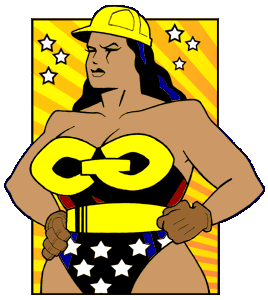CSM Fixed
Okay. I fixed the problem. It was the tappet snagging on the dings of the dials.
FWIW, when my ribber was not "working" (i.e., I didn't know what the hell I was doing), the ribber needles would tilt for two reasons:
- Out of timing - The needles weren't knitting sequentially and the cylinder needle in front of the ribber needle would pull down on the yarn. The loop would put tension on the ribber needle - thus making the needles want to tilt. I actually have a photo to show that:

- The other issue is that I may not have had the tappet plate snug with the ribber dial - thus allowing the needles room to tilt. I know this is something that a lot of people told me to look for, but I don't think that was my problem. Once I fixed the timing, the problem went away.
Anyway. When the ribber got stuck, I must have banged on the crank and in so doing, I damaged the dials.
I know there are people out there that restore CSM's - but they charge about as much as I paid for the machine (For inquiring minds: $650 - but that doesn't include the cost of new needles, stand, heel forks, etc. . .). Plus, I tend to approach things in the manner that I want to understand why things don't work so I can try to avoid doing it again. I'm a bit stubborn and sometimes need to learn the hard way to "not turn the crank when it's difficult to turn". I must admit that I did use a little brute strength on the machine when the ribber got stuck - I couldn't see why it wouldn't move, so if I just tapped it a bit to see where it was stuck. . .
Goodness I'm glad we have Internet groups. The various yahoo sockmachine groups have been really a great resource - but an even greater resource has been to just meet up with other CSM'ers. I know I've learned something new every time I've made it to a meet up.
Back to how I fixed my problem. First off, I needed to get rid of the divot in the nose of the tappet plate. The damage was relatively deep, so I dug out my handy Dremel tool and sanded down the end. Whoa buddy! A little dab will do you with the Dremel - I forgot how powerful those suckers are.
The Dremel was great on the tappet plate, but I felt that it was a little too much for the dials. So I brought out a simple medium grit sand paper - worked like a charm. I sanded both dials down, washed them and the tappet in the sink with soapy water and used a toothbrush to get the grit out of the dial slots. Re-greased everything with 3-in-1 oil and fit each dial with the ribber attachment to see if I got the same drag as I was getting before.
No. The drag is now gone and I'm feeling fairly handy right now! :)
See how shiny the ribber dial looks now? That's also a photo of the sand paper I used. It's not course at all.
I'm so cocky at this point that I reconfigure my machine to the 72 cylinder (I want to make a couple of men's socks). The ribber works great. Now I just have to pay attention to when I'm doing the heel. Don't you just hate when you go to turn the crank only to have all your work drop off before your eyes! This is a rookie mistake and I think I was just tired of fussing with the machine for the day.
But I got it working again! Whoot!
Oh, and on the pin, I just put it in to a vice and closed it to straighten out the pin. It's not perfect, but it doesn't mess with the timing any more.














No comments:
Post a Comment